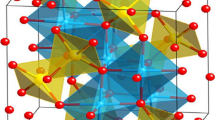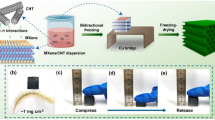Abstract
In this work, we report the synthesis of Samarium ruthenate (Sm3RuO7) in the form of nanorods for the first time using the hydrothermal method, and Sm3RuO7-MnO2 nanocomposite using the physical blending approach. To ascertain the materials´ phase formation, crystallinity, and average crystallite size, Powder X-ray diffraction (PXRD) analysis was used. The presences of vibrational modes in the samples were identified by Fourier transform infrared (FTIR) spectroscopy. X-ray photoelectron spectroscopy (XPS) was used to identify the oxidation states and chemical elements that were present on the surface of the samples. The surface morphology of the samples was tested using Field emission scanning electron microscopy (FESEM). Along with XRD analyses, the crystalline nature of the samples and d-spacing were further confirmed using Transmission Electron Microscopy (TEM) images with selected area electron diffraction (SAED). The electrochemical behaviour of the samples was examined using cyclic voltammetry and chronopotentiometry techniques. The maximum specific capacitance of Sm3RuO7/MnO2 was determined by cyclic voltammetry to be 805 F/g at a scan rate of 5 mV/s, which is higher than the 326 F/g of pure Sm3RuO7 at the same scan rate. At a current density of 1 A/g, the charge–discharge analysis of Sm3RuO7/MnO2 produced a high specific capacitance of 802 F/g. The fast charge transfer kinetics of the materials was noticeable in the electrochemical impedance spectra. The incorporation MnO2 in Sm3RuO7 provided extra interfacial sites, which led to the superior supercapacitive behaviour of the composite Sm3RuO7/MnO2.












Similar content being viewed by others
Data availability
The data used to support the findings of this study were included within the article. No supplementary information files were added.
References
G. Vignesh, P. Devendran, N. Nallamuthu, S. Sudhahar, M.K. Kumar, N-rGO / NiCo 2 O 4 nanocomposite for high performance supercapacitor applications. J. Mater. Sci. Mater. Electron. 34, 1–14 (2023). https://doi.org/10.1007/s10854-023-10242-y
V. Shanmugavalli et al., High performance NiCo 2 O 4 / PANI / graphene nanofiber for supercapacitor applications. J. Mater. Sci. Mater. Electron. 34, 1–12 (2023). https://doi.org/10.1007/s10854-023-10248-6
M. Arunkumar, A. Paul, Importance of electrode preparation methodologies in supercapacitor applications. ACS Omega (2017). https://doi.org/10.1021/acsomega.7b01275
N. Choudhary et al., Asymmetric supercapacitor electrodes and devices. Adv. Mater. (2017). https://doi.org/10.1002/adma.201605336
P. Simon, Y. Gogotsi, P. Simon, Y. Gogotsi, N. Materials, Nat. Mater. (2019). https://doi.org/10.1038/nmat2297
Series, I. O. P. C. & Science, M. Supercapacitor technology and its applications : a review Supercapacitor technology and its applications : a review. (2019) https://doi.org/10.1088/1757-899X/561/1/012105.
C. Soc, G. Wang, J. Zhang, Chem. Soc. Rev. (2012). https://doi.org/10.1039/c1cs15060j
J. Schenk, P.M. Wilde, E. Abdelmula, P. Axmann, J. Garche, J. Power. Sources 105, 182–188 (2002). https://doi.org/10.1016/S0378-7753(01)00937-5
T.N.V. Raj, P.A. Hoskeri, Facile synthesis of perovskite lanthanum aluminate and its green reduced graphene oxide composite for high performance supercapacitors. J. Electroanal. Chem. 858, 113830 (2020). https://doi.org/10.1016/j.jelechem.2020.113830
C. Dang, T.S. Algarni, A.M. Al-mohaimeed, Carbon (2020). https://doi.org/10.1016/j.carbon.2020.10.081
P.M. Wilde, T.J. Guther, R. Oesten, J. Garche, J. Electroanal. Chem. 461, 154–160 (1999). https://doi.org/10.1016/S0022-0728(98)00179-X
N. Sivakumar, Int. J. Energy Res. (2020). https://doi.org/10.1002/er.6146
M. Isacfranklin et al., Perovskite rare earth porous hollow microspheres of SmFeO3/MWCNT battery type asymmetric hybrid supercapacitors. Electrochim. Acta (2023). https://doi.org/10.1016/J.ELECTACTA.2023.142519
U.V. Gopi, P. Bhojane, K.S. Smaran, Engineering oxygen-deficient nanocomposite comprising LaNiO3-δ and reduced graphene oxide for high-performance pseudocapacitors. J. Energy Storage 54, 105301 (2022). https://doi.org/10.1016/j.est.2022.105301
P. Phumuen et al., Ball milling modification of perovskite LaNiO3 powders for enhancing electrochemical pseudocapacitor. Surfaces and Interfaces 25, 101282 (2021). https://doi.org/10.1016/j.surfin.2021.101282
E. Harputlu, Colloids Surfaces A Physicochem. Eng. Asp (2020). https://doi.org/10.1016/j.colsurfa.2021.127787
S. Arunachalam, B. Kirubasankar, D. Pan, H. Liu, C. Yan, ScienceDirect Research progress in rare earths and their composites based electrode materials for supercapacitors. Green Energy Environ. 5, 259–273 (2020). https://doi.org/10.1016/j.gee.2020.07.021
S. Liang, H. Wang, Y. Li, H. Qin et al., Sust. Energy Fuels. (2020). https://doi.org/10.1039/D0SE00669F
B.J. Rani, G. Ravi, R. Yuvakkumar, S.I. Hong, Novel SmMn 2 O 5 hollow long nano-cuboids for electrochemical supercapacitor and water splitting applications. Vacuum 166, 279–285 (2019). https://doi.org/10.1016/j.vacuum.2019.05.029
B. Jansi Rani, M. Gowsalya, G. Ravi, R. Yuvakkumar, S.I. Hong, Mater. Res. Express (2019). https://doi.org/10.1088/2053-1591/ab3333
W.R. Gemmill, M.D. Smith, H. Loye, S. Carolina, Inorganic Chem. (2004). https://doi.org/10.1021/ic049700l
M. Inabayashi, Y. Doi, M. Wakeshima, Y. Hinatsu, J. Solid State Chem. (2017). https://doi.org/10.1016/j.jssc.2017.07.022
Y. Hinatsu, Y. Doi, Structural phase transition and antiferromagnetic transition. J. Solid State Chem. 220, 22–27 (2014). https://doi.org/10.1016/j.jssc.2014.08.003
S.D. Dhas et al., Synthesis of NiO nanoparticles for supercapacitor application as an efficient electrode material. Vacuum 181, 109646 (2020). https://doi.org/10.1016/j.vacuum.2020.109646
V. Subramanian, S.C. Hall, P.H. Smith, B. Rambabu, Solid State Ionics (2004). https://doi.org/10.1016/j.ssi.2004.01.070
V. Subramanian, H. Zhu, B. Wei, Nanostructured MnO2: hydrothermal synthesis and electrochemical properties as a supercapacitor electrode material. J. Power. Sources (2006). https://doi.org/10.1016/j.jpowsour.2006.04.012
N.G. Prakash et al., High performance one dimensional α-MoO3 nanorods for supercapacitor applications. Ceram. Int. (2018). https://doi.org/10.1016/j.ceramint.2018.03.032
X. Zhang et al., Polydopamine-assisted formation of Co 3 O 4 -nanocube-anchored reduced graphene oxide composite for high-performance supercapacitors. Ceram. Int. 45, 13894–13902 (2019). https://doi.org/10.1016/j.ceramint.2019.04.087
Z. Fan et al., Adv. Funct. Mater. (2011). https://doi.org/10.1002/adfm.201100058
X. Lu et al., Facile synthesis of large-area manganese oxide nanorod arrays as a high-performance electrochemical supercapacitor. Energy Environ. Sci. 4, 2915–2921 (2011). https://doi.org/10.1039/C1EE01338F
Poonam, K. Sharma, A. Arora, S.K. Tripathi, Review of supercapacitors: Materials and devices. J. Energy Storage. (2019). https://doi.org/10.1016/j.est.2019.01.010
P. Kulkarni, S.K. Nataraj, R.G. Balakrishna, D.H. Nagaraju, M.V. Reddy, Nanostructured binary and ternary metal sulfides: synthesis methods and their application in energy conversion and storage devices. J. Mater. Chem. A Mater. energy Sustain. (2017). https://doi.org/10.1039/C7TA07329A
M.A. Mahadadalkar et al., Architecture of the CdIn2S4/graphene nano-heterostructure for solar hydrogen production and anode for lithium ion battery. RSC Adv. 6, 34724–34736 (2016). https://doi.org/10.1039/C6RA02002J
R.A. Davoglio, G. Cabello, J.F. Marco, S.R. Biaggio, Electrochim. Acta (2018). https://doi.org/10.1016/j.electacta.2017.12.118
Jaidev, R.I. Jafri, A.K. Mishra, S. Ramaprabhu, Polyaniline-MnO2 nanotube hybrid nanocomposite as supercapacitor electrode material in acidic electrolyte. J. Mater. Chem. (2011). https://doi.org/10.1039/C1JM13191E
M. Rabiei, A. Palevicius, A. Monshi, S. Nasiri, Nanomaterials (2020). https://doi.org/10.3390/nano10091627
K.A. Aly, N.M. Khalil, Y. Algamal, Q.M.A. Saleem, Lattice strain estimation for CoAl2O4 nano particles using Williamson-Hall analysis. J. Alloys Compd. (2016). https://doi.org/10.1016/j.jallcom.2016.03.213
U.M. Patil, S.B. Kulkarni, V.S. Jamadade, C.D. Lokhande, Chemically synthesized hydrous RuO2 thin films for supercapacitor application. J. Alloys Compd. 509, 1677–1682 (2011)
H. Wang, Z. Lu, D. Qian, Y. Li, Nanotechnology (2007). https://doi.org/10.1088/0957-4484/18/11/115616
A. Shiralizadeh, M.R. Ganjali, Appl. Surface Sci. (2017). https://doi.org/10.1016/j.apsusc.2017.01.021
B.T. Sone, E. Manikandan, A. Gurib-fakim, M. Maaza, Sm 2O3 nanoparticles green synthesis via callistemon viminalis’ extract. J. Alloys Compd. 650, 357–362 (2015). https://doi.org/10.1016/j.jallcom.2015.07.272
E.E. Khawaja, M.A. Salim, M.A. Khan, F.F. Al-Adel, G.D. Khattak, Z. Hussain, XPS, auger, electrical and optical studies of vanadium phosphate glasses doped with nickel oxide. J. non-crystalline solids (1989). https://doi.org/10.1016/0022-3093(89)90179-8
H. Brunckova, M. Kanuchova, H. Kolev, E. Mudra, XPS characterization of Sm Nb O 4 and Sm Ta O 4 precursors prepared by Sol-Gel method. Appl. Surface Sci. (2018). https://doi.org/10.1016/j.apsusc.2018.12.143
A.S. Dezfuli, M.R. Ganjali, H.R. Naderi, Anchoring samarium oxide nanoparticles on reduced graphene oxide for high-performance supercapacitor. Appl. Surf. Sci. (2017). https://doi.org/10.1016/j.apsusc.2017.01.021
Y. Guo, W. Zhang, Y. Sun, M. Dai, Electrochimica acta ruthenium nanoparticles stabilized by mercaptan and acetylene derivatives with supercapacitor application. Electrochim. Acta 270, 284–293 (2018). https://doi.org/10.1016/j.electacta.2018.03.037
J. Zhang et al., Template synthesis of tubular ruthenium oxides for supercapacitor applications. J. Phys. Chem. C (2010). https://doi.org/10.1021/jp105146c
D.J. Morgan, Resolving ruthenium : XPS studies of common ruthenium materials. Surf. Interface Anal. (2015). https://doi.org/10.1002/sia.5852
J. Singh, A. Roychoudhury, M. Srivastava, P.R. Solanki, J. Mater. Chem. B (2013). https://doi.org/10.1039/c3tb20690d
P.E. Saranya, S. Selladurai, Efficient electrochemical performance of ZnMn2O4 nanoparticles with rGO nanosheets for electrodes in supercapacitor applications. J. Mater. Sci. Mater. Electron. (2017). https://doi.org/10.1007/s10854-017-8268-5
S. Alonso, A. Palomo, Alkaline activation of metakaolin and calcium hydroxide mixtures : influence of temperature, activator concentration and solids ratio. Mater. Lett. (2001). https://doi.org/10.1016/S0167-577X(00)00212-3
D. Majumdar, T.Z. MaiyalaganJiang, Recent progress in ruthenium oxide-based composites for supercapacitor applications. Chem. Electro. Chem (2019). https://doi.org/10.1002/celc.201900668
S.B. Ubale et al., Electrochemical behavior of hydrothermally synthesized porous groundnuts - like samarium oxide thin films. SN Appl. Sci. (2020). https://doi.org/10.1007/s42452-020-2467-z
T. Wang et al., Facilitated transport channels in carbon nanotube / carbon nano fi ber hierarchical composites decorated with manganese dioxide for fl exible supercapacitors. J. Power. Sources 274, 709–717 (2015). https://doi.org/10.1016/j.jpowsour.2014.10.102
Z.M. Riyas, M.R. Prabhu et al., Hydrothermal synthesis of La 2 O 3—ZnO nanocomposites as electrode materials for asymmetric supercapacitor applications. J. Mater. Sci. Mater. Electron. 34, 1–19 (2023). https://doi.org/10.1007/s10854-023-10988-5
A.I. Inamdar et al., Chemically grown, porous, nickel oxide thin-film for electrochemical supercapacitors. J. Power. Sources 196, 2393–2397 (2011). https://doi.org/10.1016/j.jpowsour.2010.09.052
K.S. Elmessiry et al., Free—standing working electrodes for supercapacitors based on composite polymer nanofibers and functionalized with graphene oxide. J. Electron. Mater. 50, 5599–5611 (2021). https://doi.org/10.1007/s11664-021-09120-2
M.M. Vadiyar, S.C. Bhise, S.K. Patil et al., Mechanochemical growth of porous ZnFe2O4 nano-flakes thin film as electrode for supercapacitor application. RSC Adv. (2015). https://doi.org/10.1039/C5RA07588B
Author information
Authors and Affiliations
Contributions
All authors contributed to this study conception and design. YV: Resources, Formal analysis, Writing—review and editing, Supervision, MS: Investigation, Methodology, Writing—draft and DG: Resources and Supervision.
Corresponding author
Ethics declarations
Competing interest
The authors declare no competing financial interest.
Ethical approval
All procedures performed in this study do not harm /use any animals or humans.
Additional information
Publisher's Note
Springer Nature remains neutral with regard to jurisdictional claims in published maps and institutional affiliations.
Rights and permissions
Springer Nature or its licensor (e.g. a society or other partner) holds exclusive rights to this article under a publishing agreement with the author(s) or other rightsholder(s); author self-archiving of the accepted manuscript version of this article is solely governed by the terms of such publishing agreement and applicable law.
About this article
Cite this article
Vidyalakshmi, Y., Vaishali, M.S. & Geetha, D. Synthesis and supercapacitor performance of Sm3RuO7 nanorods and Sm3RuO7/MnO2 nanocomposite. J Mater Sci: Mater Electron 35, 510 (2024). https://doi.org/10.1007/s10854-024-12191-6
Received:
Accepted:
Published:
DOI: https://doi.org/10.1007/s10854-024-12191-6




